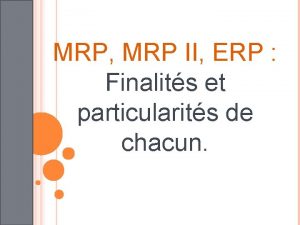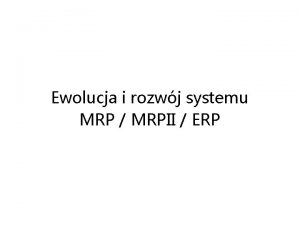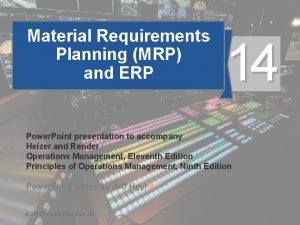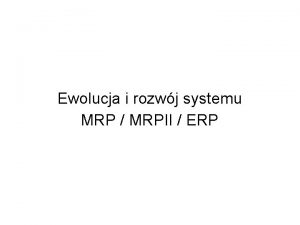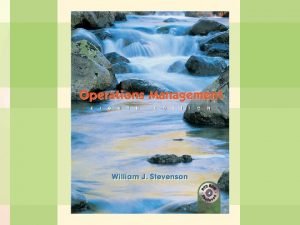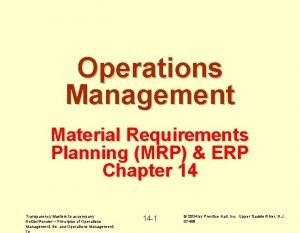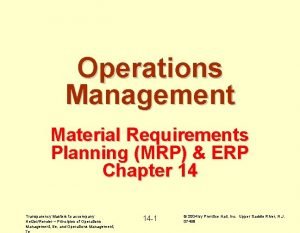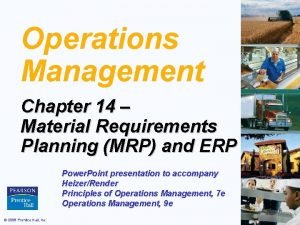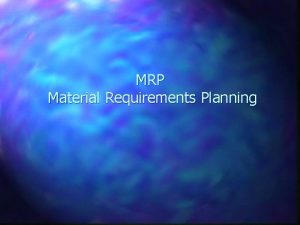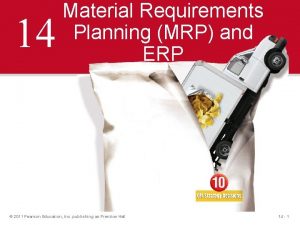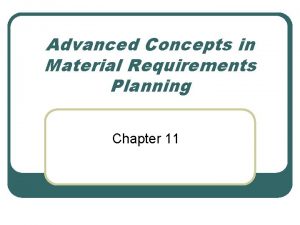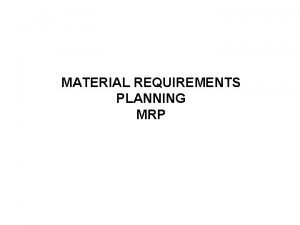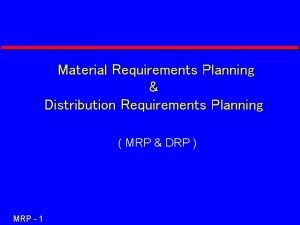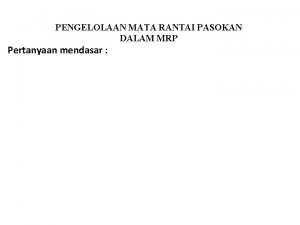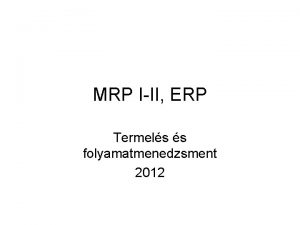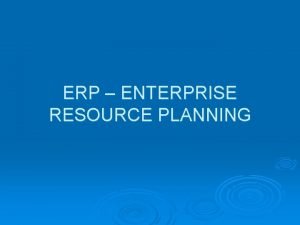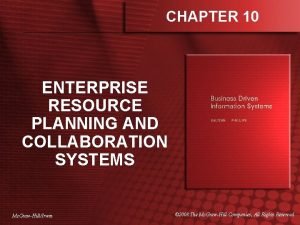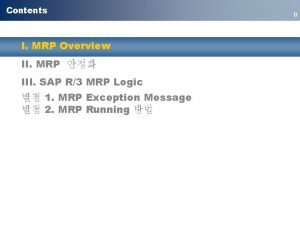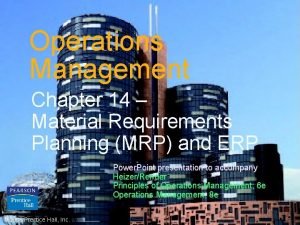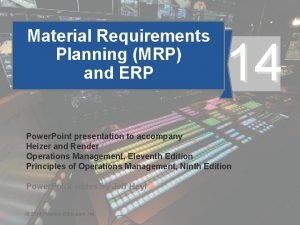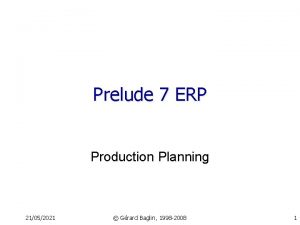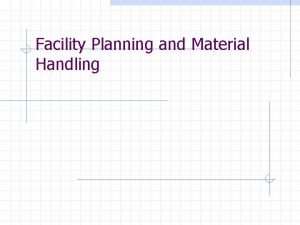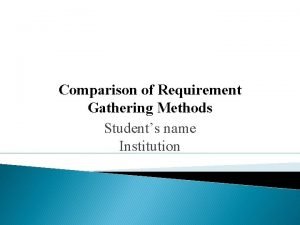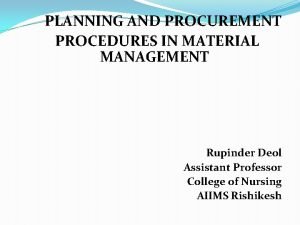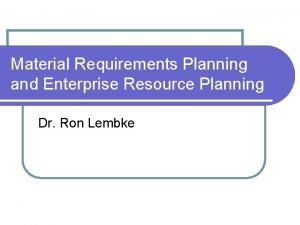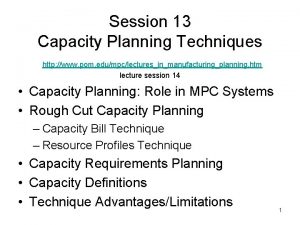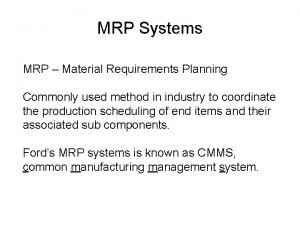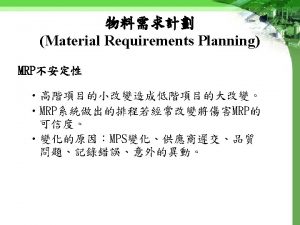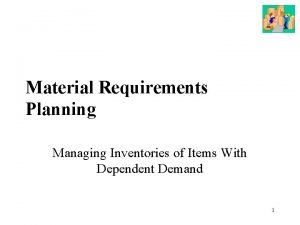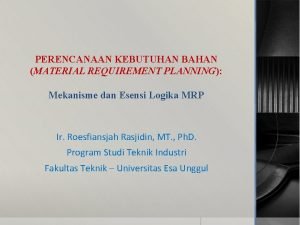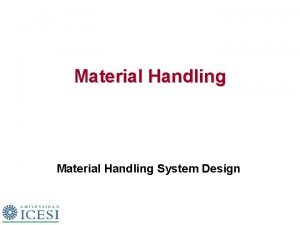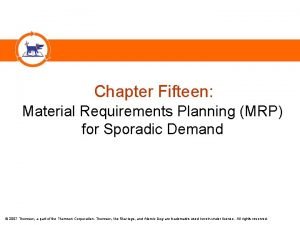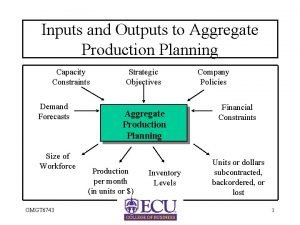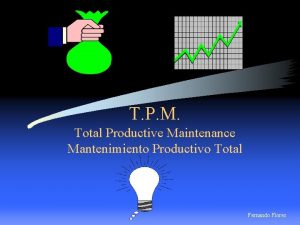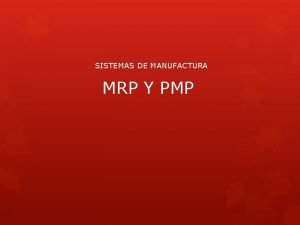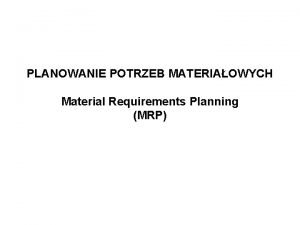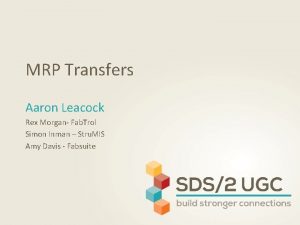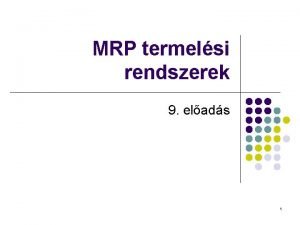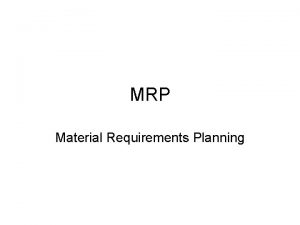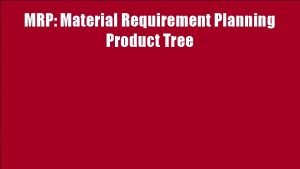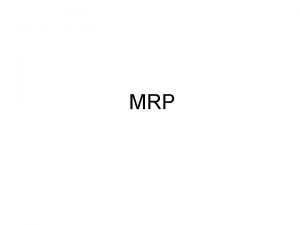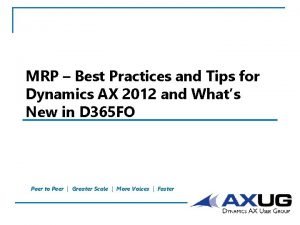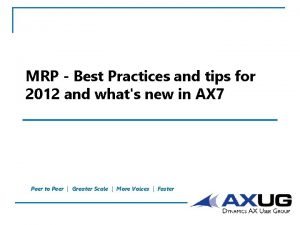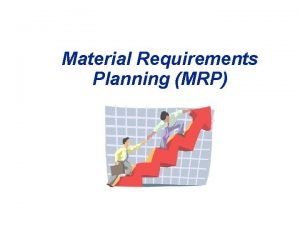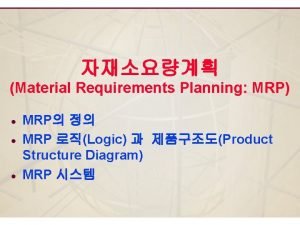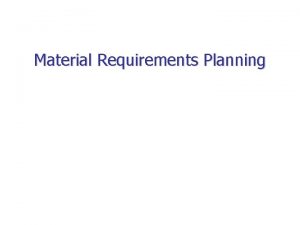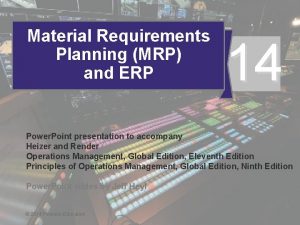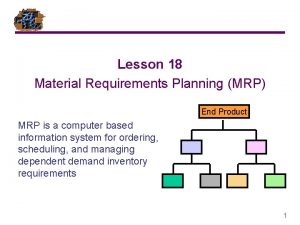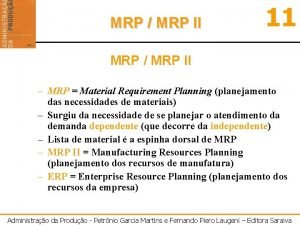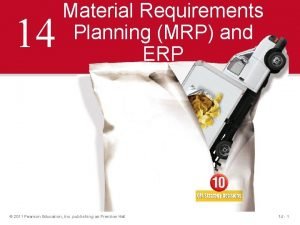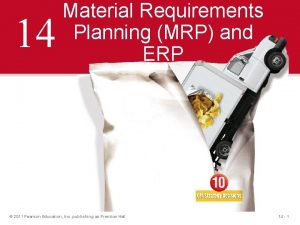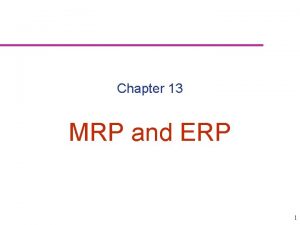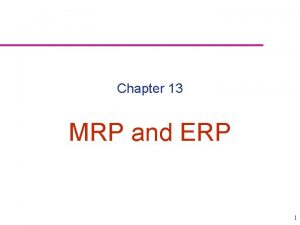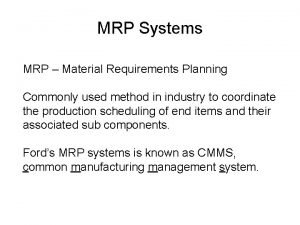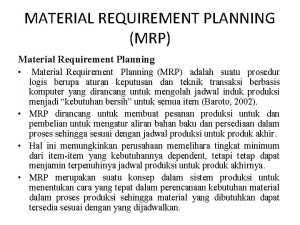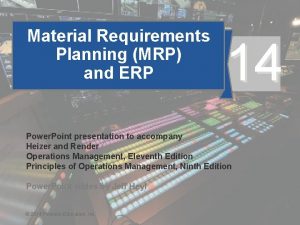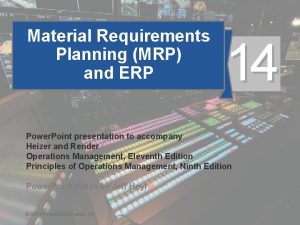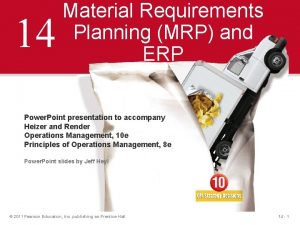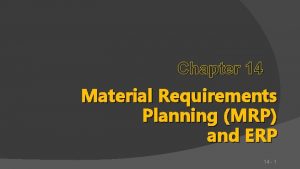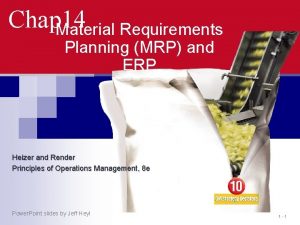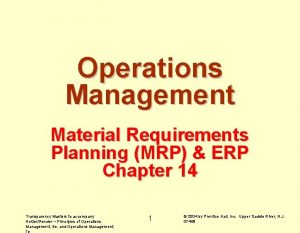14 Material Requirements Planning MRP and ERP 2011






































































- Slides: 70

14 Material Requirements Planning (MRP) and ERP © 2011 Pearson Education, Inc. publishing as Prentice Hall 14 - 1

Outline u Dependent Demand u Dependent Inventory Model Requirements u Master Production Schedule u Bills of Material u Accurate Inventory Records u Purchase Orders Outstanding u Lead Times for Components © 2011 Pearson Education, Inc. publishing as Prentice Hall 14 - 2

Outline – Continued u MRP Structure u MRP Management u Lot-Sizing Techniques u Lot-for-Lot (LFL), u Economic Order Quantity (EOQ), u Periodic Order Quantity (POQ) © 2011 Pearson Education, Inc. publishing as Prentice Hall 14 - 3

Outline – Continued u Extensions of MRP u Material Requirements Planning II (MRP II) u Closed-Loop MRP u Capacity Planning u Enterprise Resource Planning (ERP) u MRP In Services, u Resource Planning (DRP) © 2011 Pearson Education, Inc. publishing as Prentice Hall 14 - 4

Learning Objectives When you complete this chapter you should be able to: 1. Develop a product structure 2. Build a gross requirements plan 3. Build a net requirements plan 4. Determine lot sizes for lot-for-lot (LFL), Economic Order Quantity (EOQ), and Periodic Order Quantity (POQ) 5. Know recent extensions to MRP © 2011 Pearson Education, Inc. publishing as Prentice Hall 14 - 5

Wheeled Coach u Largest manufacturer of ambulances in the world u International competitor u 12 major ambulance designs u 18, 000 different inventory items u 6, 000 manufactured parts u 12, 000 purchased parts © 2011 Pearson Education, Inc. publishing as Prentice Hall 14 - 6

Dependent Demand u The demand for one item is related to the demand for another item u Given a quantity for the end item, the demand for all parts and components can be calculated © 2011 Pearson Education, Inc. publishing as Prentice Hall 14 - 7

Trumpet and Subassemblies 14 - 8

Bill-of-Material for Trumpet 14 - 9

Benefits of MRP 1. Better response to customer orders 2. Faster response to market changes 3. Improved utilization of facilities and labor 4. Reduced inventory levels © 2011 Pearson Education, Inc. publishing as Prentice Hall 14 - 10

The Planning Process Production Capacity Inventory Marketing Customer demand Procurement Supplier performance Finance Cash flow Human resources Manpower planning Management Return on investment Capital Aggregate production plan Master production schedule © 2011 Pearson Education, Inc. publishing as Prentice Hall Engineering Design completion Change production plan? Figure 14. 1 14 - 11

The Planning Process Master production schedule Change requirements? Change master production schedule? Material requirements plan Change capacity? Capacity requirements plan No Realistic? Yes Is capacity plan being met? Is execution meeting the plan? Execute capacity plans Execute material plans © 2011 Pearson Education, Inc. publishing as Prentice Hall Figure 14. 1 14 - 12

MRP u MRP is a dependent demand technique that uses u Bill-of-Material (BOM) u On-hand inventory data u Expected receipts (outstanding purchase orders) u Master Production Schedule (MPS) u Lead Time information to determine material requirements. 14 - 13

MRP Structure Data Files Output Reports BOM MRP by period report Master production schedule MRP by date report Lead times Planned order report (Item master file) Inventory data Purchasing data Material requirement planning programs (computer and software) Purchase advice Exception reports Order early or late or not needed Order quantity too small or too large Figure 14. 5 © 2011 Pearson Education, Inc. publishing as Prentice Hall 14 - 14

Master Production Schedule (MPS) u Specifies what is to be made and when u Must be in accordance with the aggregate production plan u Uses inputs from financial plans, customer demand, engineering, suppliers u As the process moves from planning to execution, each step must be tested for feasibility u The MPS is the result of the production planning process © 2011 Pearson Education, Inc. publishing as Prentice Hall 14 - 15

Master Production Schedule (MPS) u MPS is established in terms of specific products u Schedule must be followed for a reasonable length of time u The MPS is quite often fixed or frozen in the near term part of the plan u The MPS is a rolling schedule u The MPS is a statement of what is to be produced, not a forecast of demand © 2011 Pearson Education, Inc. publishing as Prentice Hall 14 - 16

Aggregate Production Plan Months Aggregate Production Plan (Shows the total quantity of amplifiers) Weeks Master Production Schedule (Shows the specific type and quantity of amplifier to be produced 240 -watt amplifier 150 -watt amplifier 75 -watt amplifier 1 January February 1, 500 1, 200 2 100 3 4 100 500 6 100 500 300 5 7 8 100 450 100 Figure 14. 2 © 2011 Pearson Education, Inc. publishing as Prentice Hall 14 - 17

MPS Examples For Nancy’s Specialty Foods Gross Requirements for Crabmeat Quiche Day Amount 6 50 7 8 100 9 47 10 60 11 12 110 13 75 14 and so on Gross Requirements for Spinach Quiche Day Amount 7 8 9 100 200 150 10 11 12 60 13 75 14 15 100 16 and so on Table 14. 1 © 2011 Pearson Education, Inc. publishing as Prentice Hall 14 - 18

Bills of Material u List of components, ingredients, and materials needed to make product u Provides product structure u Items above given level are called parents u Items below given level are called children © 2011 Pearson Education, Inc. publishing as Prentice Hall 14 - 19

BOM Example Level Product structure for “Awesome” (A) 0 A 1 2 3 12” Speaker kit w/ C(3) Std. amp-booster B(2) Std. 12” Speaker kit E(2) D(2) F(2) Std. 12” Speaker E(2) Packing box and installation kit of wire, bolts, and screws booster assembly G(1) D(2) Amp-booster 12” Speaker © 2011 Pearson Education, Inc. publishing as Prentice Hall 12” Speaker 14 - 20

BOM Example Level Product structure for “Awesome” (A) 0 A 1 2 3 D(2) Part B: 2 x number of As = (2)(50) =Std. 12” Speaker 100 kit w/ BPart 12” Speaker kit C (2) Std. (3) C: 3 x number of As = (3)(50) =amp-booster 150 Part D: 2 x number of Bs + 2 x number of Fs = (2)(100) + (2)(300) = 800 E(2) 2 x number of Bs E(2) F(2) Std. 12” Speaker Part E: booster assembly + 2 x number of Cs = (2)(100) + (2)(150) = 500 Part F: 2 x Packing numberbox ofand Cs = (2)(150) = 300 kit of wire, G(1) = D(2) Part G: 1 installation xbolts, number of Fs = (1)(300) 300 and screws Amp-booster 12” Speaker © 2011 Pearson Education, Inc. publishing as Prentice Hall 12” Speaker 14 - 21

Accurate Records for Outstanding Purchase Orders u Accurate inventory records are absolutely required for MRP (or any dependent demand system) to operate correctly u Generally MRP systems require more than 99% accuracy u Outstanding purchase orders must accurately reflect quantities and scheduled receipts © 2011 Pearson Education, Inc. publishing as Prentice Hall 14 - 22

Lead Times u The time required to purchase, produce, or assemble an item u For production – the sum of the order, wait, move, setup, store, and run times u For purchased items – the time between the recognition of a need and the availability of the item for production © 2011 Pearson Education, Inc. publishing as Prentice Hall 14 - 23

Time-Phased Product Structure Must have D and E completed here so production can begin on B Start production of D 1 week D 2 weeks to produce B 2 weeks E A 2 weeks 1 week E 1 week 2 weeks G C 3 weeks F 1 week D | | | 1 2 3 | | 4 5 Time in weeks © 2011 Pearson Education, Inc. publishing as Prentice Hall | | | 6 7 8 Figure 14. 4 14 - 24

Determining Gross Requirements u Starts with a production schedule for the end item – 50 units of Item A in week 8 u Using the lead time for the item, determine the week in which the order should be released – a 1 week lead time means the order for 50 units should be released in week 7 u This step is often called “lead time offset” or “time phasing” © 2011 Pearson Education, Inc. publishing as Prentice Hall 14 - 25

Determining Gross Requirements u From the BOM, every Item A requires 2 Item Bs – 100 Item Bs are required in week 7 to satisfy the order release for Item A u The lead time for the Item B is 2 weeks – release an order for 100 units of Item B in week 5 u The timing and quantity for component requirements are determined by the order release of the parent(s) © 2011 Pearson Education, Inc. publishing as Prentice Hall 14 - 26

Determining Gross Requirements u The process continues through the entire BOM one level at a time – often called “explosion” u By processing the BOM by level, items with multiple parents are only processed once, saving time and resources and reducing confusion u Low-level coding ensures that each item appears at only one level in the BOM © 2011 Pearson Education, Inc. publishing as Prentice Hall 14 - 27

Gross Requirements Plan 1 A. Required date Order release date B. Required date Order release date C. Required date Order release date E. Required date Order release date F. Required date Order release date D. Required date Order release date G. Required date Order release date 2 3 Week 4 5 6 7 50 100 150 200 300 300 600 300 200 150 8 Lead Time 50 1 week 2 weeks 3 weeks 1 week 2 weeks Table 14. 3 © 2011 Pearson Education, Inc. publishing as Prentice Hall 14 - 28

Net Requirements Plan © 2011 Pearson Education, Inc. publishing as Prentice Hall 14 - 29

Net Requirements Plan © 2011 Pearson Education, Inc. publishing as Prentice Hall 14 - 30

Determining Net Requirements u Starts with a production schedule for the end item – 50 units of Item A in week 8 u Because there are 10 Item As on hand, only 40 are actually required – (net requirement) = (gross requirement - onhand inventory) u The planned order receipt for Item A in week 8 is 40 units – 40 = 50 - 10 © 2011 Pearson Education, Inc. publishing as Prentice Hall 14 - 31

Determining Net Requirements u Following the lead time offset procedure, the planned order release for Item A is now 40 units in week 7 u The gross requirement for Item B is now 80 units in week 7 u There are 15 units of Item B on hand, so the net requirement is 65 units in week 7 u A planned order receipt of 65 units in week 7 generates a planned order release of 65 units in week 5 © 2011 Pearson Education, Inc. publishing as Prentice Hall 14 - 32

Determining Net Requirements u A planned order receipt of 65 units in week 7 generates a planned order release of 65 units in week 5 u The on-hand inventory record for Item B is updated to reflect the use of the 15 items in inventory and shows no on-hand inventory in week 8 u This is referred to as the Gross-to-Net calculation and is the third basic function of the MRP process © 2011 Pearson Education, Inc. publishing as Prentice Hall 14 - 33

Gross Requirements Schedule Figure 14. 6 S A B B C Lead time = 4 for A Master schedule for A Periods 5 6 7 40 Periods Gross requirements: B 8 9 10 11 50 15 1 2 10 40+10 =50 © 2011 Pearson Education, Inc. publishing as Prentice Hall 3 40 C Lead time = 6 for S Master schedule for S 8 9 10 11 12 13 40 4 50 5 20 6 20 7 15+30 =45 30 Master schedule for B sold directly 1 2 3 10 10 8 Therefore, these are the gross requirements for B 14 - 34

Net Requirements Plan The logic of net requirements Gross Allocations requirements + Total requirements – On Scheduled + hand receipts Net = requirements Available inventory © 2011 Pearson Education, Inc. publishing as Prentice Hall 14 - 35

Allocations u Allocated items refer to the number of units in inventory that have ben assigned to specific future production but not yet used or issued from the stock room. u The following slide illustrates how allocated items increase gross requirements 14 - 36

MRP Planning Sheet Figure 14. 7 © 2011 Pearson Education, Inc. publishing as Prentice Hall 14 - 37

Safety Stock u BOMs, inventory records, purchase and production quantities may not be perfect u Consideration of safety stock may be prudent u Should be minimized and ultimately eliminated because of its domino effect u Typically built into projected on-hand inventory © 2011 Pearson Education, Inc. publishing as Prentice Hall 14 - 38

MRP Management u MRP does not do detailed scheduling–it plans u Works best in product-focused, repetitive environments u MRP is a dynamic system u Facilitates replanning when changes occur u Regenerating u Net change u System nervousness can result from too many changes (Limiting replaning with Time fences, Linking Parent to Child, Pegging) © 2011 Pearson Education, Inc. publishing as Prentice Hall 14 - 39

Finite Capacity Scheduling u MRP systems do not consider capacity during normal planning cycles u Finite capacity scheduling (FCS) recognizes actual capacity limits u By merging MRP and FCS, a finite schedule is created with feasible capacities which facilitate rapid material movement © 2011 Pearson Education, Inc. publishing as Prentice Hall 14 - 40

Lot-Sizing Techniques u Lot-for-lot techniques order just what is required for production based on net requirements u May not always be feasible u If setup costs are high, lot-for-lot can be expensive u Economic order quantity (EOQ) u EOQ expects a known constant demand MRP systems often deal with unknown and variable demand © 2011 Pearson Education, Inc. publishing as Prentice Hall 14 - 41

Lot-Sizing Techniques u Periodic Order Quantity (POQ) looks at future orders to determine most economic lot size u The Wagner-Whitin algorithm is a complex dynamic programming technique u Assumes a finite time horizon u Effective, but computationally burdensome © 2011 Pearson Education, Inc. publishing as Prentice Hall 14 - 42

Lot-for-Lot Example Gross requirements 1 2 3 4 5 6 7 8 9 10 35 30 40 0 10 40 30 55 35 0 0 0 0 0 30 40 0 10 40 30 55 30 40 10 40 30 30 55 40 30 Scheduled receipts Projected on hand Net requirements 35 Planned order receipts Planned order releases 30 40 10 30 55 Holding cost = $1/week; Setup cost = $100; Lead time = 1 week © 2011 Pearson Education, Inc. publishing as Prentice Hall 14 - 43

Lot-for-Lot Example No on-hand inventory is carried through the system Total holding cost = $0 1 2 3 4 5 6 7 8 9 10 Gross 30 40 this 0 10 30 There are seven 35 setups for item 40 in this plan requirements Total ordering cost = 7 x $100 = $700 Scheduled 55 receipts Projected on hand Net requirements 35 35 0 0 0 0 0 30 40 0 10 40 30 55 30 40 10 40 30 30 55 40 30 Planned order receipts Planned order releases 30 40 10 30 55 Holding cost = $1/week; Setup cost = $100; Lead time = 1 week © 2011 Pearson Education, Inc. publishing as Prentice Hall 14 - 44

EOQ Lot Size Example Gross requirements 1 2 3 4 5 6 7 8 9 10 35 30 40 0 10 40 30 55 35 0 43 3 3 66 26 69 69 39 0 30 0 0 7 0 4 0 0 16 Scheduled receipts Projected on hand Net requirements 35 Planned order receipts Planned order releases 73 73 Holding cost = $1/week; Setup cost = $100; Lead time = 1 week Average weekly gross requirements = 27; EOQ = 73 units © 2011 Pearson Education, Inc. publishing as Prentice Hall 14 - 45

Calculating EQO u Annual demand (D): (270/10)*52=1404 u Setup Cost (S)= $100 u Holding Cost (H) = $1*52= $52 u EOQ= 73 units © 2011 Pearson Education, Inc. publishing as Prentice Hall 14 - 46

EOQ Lot Size Example Gross requirements 1 2 3 4 5 6 7 8 9 10 35 30 40 0 10 40 30 55 35 0 43 3 3 66 26 69 69 39 0 30 0 0 7 0 4 0 0 16 Scheduled receipts Projected on hand Net requirements 35 Planned order receipts Planned order releases 73 73 Holding cost = $1/week; Setup cost = $100; Lead time = 1 week Average weekly gross requirements = 27; EOQ = 73 units © 2011 Pearson Education, Inc. publishing as Prentice Hall 14 - 47

EOQ Lot Size Example u. Annual demand = 1, 404 u. Total cost = setup cost + holding cost u. Total cost = (1, 404/73) x $100 + (73/2) x ($1 x 52 weeks) u. Total cost = $3, 798 u. Cost for 10 weeks = $3, 798 x (10 weeks/52 weeks) = $730 © 2011 Pearson Education, Inc. publishing as Prentice Hall 14 - 48

Lot-Sizing Techniques ▶ Periodic order quantity (POQ) orders quantity needed for a predetermined time period ▶ Interval = EOQ / average demand period ▶ Order quantity set to cover the interval ▶ Order quantity calculated when order is released 14 - 49

POQ Lot Size Example WEEK Gross requirements 1 2 3 4 5 6 7 8 9 10 35 30 40 0 10 40 30 55 35 0 40 0 0 70 30 0 0 55 0 30 0 0 10 0 0 55 0 85 0 Scheduled receipts Projected on hand Net requirements 35 Planned order receipts Planned order releases 70 70 80 80 0 85 EOQ = 73 units; Average weekly gross requirements = 27; POQ interval = 73/27 ≅ 3 weeks 14 - 50

POQ Lot Size Example u Setups = 3 x $100 = $300 u Holding cost = (40 + 70 + 30 + 55) units x $1 = $195 u Total cost = $300 + $195 = $495 © 2011 Pearson Education, Inc. publishing as Prentice Hall 14 - 51

Lot-Sizing Summary For these three examples Lot-for-lot EOQ POQ $700 $730 $495 a d e d l e i y ve a h d l u o w n i t i h W 5 r 5 e 4 n $ f o Wag t s l co a t o t a h t i plan w © 2011 Pearson Education, Inc. publishing as Prentice Hall 14 - 52

Extensions of MRP u MRP II u Closed-Loop MRP u MRP system provides input to the capacity plan, MPS, and production planning process u Capacity Planning u MRP system generates a load report which details capacity requirements u This is used to drive the capacity planning process u Changes pass back through the MRP system for rescheduling © 2011 Pearson Education, Inc. publishing as Prentice Hall 14 - 53

Material Requirements Planning II ▶ Requirement data can be enriched by other resources ▶ Generally called MRP II or Material Resource Planning ▶ Outputs can include scrap, packaging waste, effluent, carbon emissions ▶ Data used by purchasing, production scheduling, capacity planning, inventory, warehouse management 14 - 54

Material Resource Planning TABLE 14. 4 Material Resource Planning (MRP II) Weeks LT Computer 5 6 7 8 1 100 Labor Hrs: . 2 each 20 Machine Hrs: . 2 each 20 Scrap: 1 ounce fiberglass each 6. 25 Payables: $0 each PC Board (1 each) $0 2 100 Labor Hrs: . 15 each 15 Machine Hrs: . 1 each 10 Scrap: . 5 ounces copper each 3. 125 Payables: raw material at $5 each $500 Processors (5 each) lb 4 lb 500 Labor Hrs: . 2 each 100 Machine Hrs: . 2 each 100 Scrap: . 01 ounces of acid waste each 0. 3125 Payables: processors at $10 each $5, 000 lb 14 - 55

Closed-Loop MRP System Figure 14. 7 Aggregate Plan OK? NO Priority Management Capacity Management Develop Master Production Schedule Evaluate Resource Availability (Rough Cut) OK? YES Prepare Materials Requirements Pan Planning Determine Capacity Availability OK? YES Detailed Production Activity Control (Shop Scheduling/Dispatching) Implement Input/Output Control Execution (in repetitive systems JIT techniques are used) 14 - 56

Capacity Planning ▶ Feedback from the MRP system ▶ Load reports show resource requirements for work centers ▶ Work can be moved between work centers to smooth the load or bring it within capacity 14 - 57

Enterprise Resource Planning (ERP) u An extension of the MRP system to tie in customers and suppliers u Allows automation and integration of many business processes u Shares common data bases and business practices u Produces information in real time u Coordinates business from supplier evaluation to customer invoicing u ERP can be highly customized to meet specific business requirements © 2011 Pearson Education, Inc. publishing as Prentice Hall 14 - 58

Enterprise Resource Planning (ERP) u ERP modules include u Basic MRP u Finance u Human resources u Supply chain management (SCM) u Customer relationship management (CRM) © 2011 Pearson Education, Inc. publishing as Prentice Hall 14 - 59

ERP and MRP Figure 14. 11 © 2011 Pearson Education, Inc. publishing as Prentice Hall 14 - 60

ERP and MRP Customer Relationship Management Invoicing Sales Order (order entry, product configuration, sales management) Shipping Distributors, retailers, and end users Figure 14. 11 © 2011 Pearson Education, Inc. publishing as Prentice Hall 14 - 61

ERP and MRP Master Production Schedule Inventory Management Bills of Material MRP Work Orders Purchasing and Lead Times Table 13. 6 Routings and Lead Times Figure 14. 11 © 2011 Pearson Education, Inc. publishing as Prentice Hall 14 - 62

ERP and MRP Supply Chain Management Vendor Communication (schedules, EDI, advanced shipping notice, e-commerce, etc. ) Figure 14. 11 © 2011 Pearson Education, Inc. publishing as Prentice Hall 14 - 63

Finance/ Accounting ERP and MRP Accounts Receivable General Ledger Accounts Payable Payroll Figure Table 14. 11 13. 6 © 2011 Pearson Education, Inc. publishing as Prentice Hall 14 - 64

SAP’s ERP Modules © 2011 Pearson Education, Inc. publishing as Prentice Hall Figure 14. 12 14 - 65

SAP u SAP, started in 1972 by five former IBM employees in Mannheim, Germany u It is the world's fourth-largest independent software supplier. u The original name for SAP was German: Systeme, Anwendungen, Produkte, German for "Systems Applications and Products © 2011 Pearson Education, Inc. publishing as Prentice Hall 14 - 66

Advantages of ERP Systems 1. Provides integration of the supply chain, production, and administration 2. Creates commonality of databases 3. Can incorporate improved best processes 4. Increases communication and collaboration between business units and sites 5. Has an off-the-shelf software database 6. May provide a strategic advantage © 2011 Pearson Education, Inc. publishing as Prentice Hall 14 - 67

Disadvantages of ERP Systems 1. Is very expensive to purchase and even more so to customize 2. Implementation may require major changes in the company and its processes 3. Is so complex that many companies cannot adjust to it 4. Involves an ongoing, possibly never completed, process for implementation 5. Expertise is limited with ongoing staffing problems © 2011 Pearson Education, Inc. publishing as Prentice Hall 14 - 68

ERP in the Service Sector u ERP systems have been developed for health care, government, retail stores, hotels, and financial services u Also called efficient consumer response (ECR) systems u Objective is to tie sales to buying, inventory, logistics, and production © 2011 Pearson Education, Inc. publishing as Prentice Hall 14 - 69

Distribution Resource Planning (DRP) Using dependent demand techniques through the supply chain u Expected demand or sales forecasts become gross requirements u Minimum levels of inventory to meet customer service levels u Accurate lead times u Definition of the distribution structure © 2011 Pearson Education, Inc. publishing as Prentice Hall 14 - 70
 Mrp mrp ii erp
Mrp mrp ii erp Mrp ii system
Mrp ii system Material requirement planning table
Material requirement planning table Mrp iii
Mrp iii Mrp and erp operations management
Mrp and erp operations management Mrp principles
Mrp principles Mrp and erp operations management
Mrp and erp operations management Mrp in operations management
Mrp in operations management Material requirements planning
Material requirements planning Material requirements planning
Material requirements planning Material requirements planning concepts
Material requirements planning concepts Net requirements mrp
Net requirements mrp Distribution requirements planning
Distribution requirements planning Pertanyaan tentang manajemen rantai pasokan
Pertanyaan tentang manajemen rantai pasokan Függő keresletű készlet
Függő keresletű készlet Mrp erp definition
Mrp erp definition Core and extended erp components
Core and extended erp components Sap procurement type
Sap procurement type Geometric tolerance
Geometric tolerance Cultural relativism
Cultural relativism Material and non material culture examples
Material and non material culture examples Example of material culture
Example of material culture Harmful or useful
Harmful or useful Product structure tree example
Product structure tree example Los dientes
Los dientes Material requirement planning table
Material requirement planning table Erp production planning
Erp production planning Material handling and facilities planning
Material handling and facilities planning Requirements gathering techniques agile
Requirements gathering techniques agile Material management planning and procurement
Material management planning and procurement Standard costing formula
Standard costing formula Wedding planning system
Wedding planning system Enterprise requirements planning
Enterprise requirements planning Capacity planning techniques
Capacity planning techniques Capacity requirements planning
Capacity requirements planning Capacity requirements planning
Capacity requirements planning Inactivism planning
Inactivism planning Short, medium and long term planning in education
Short, medium and long term planning in education Language policy and planning slideshare
Language policy and planning slideshare Pegging report
Pegging report Material requirement planning calculation example
Material requirement planning calculation example Contoh material requirement planning
Contoh material requirement planning Unit load example
Unit load example Mrp crp
Mrp crp Mdp and mrp examples
Mdp and mrp examples Aggregate production planning example
Aggregate production planning example Strategic planning vs tactical planning
Strategic planning vs tactical planning Planning balance sheet in urban planning
Planning balance sheet in urban planning Role segmentation workforce planning
Role segmentation workforce planning Perencanaan agregat
Perencanaan agregat Aggregate capacity planning
Aggregate capacity planning Examples of aggregate planning
Examples of aggregate planning National population and housing census 2011
National population and housing census 2011 Gleitman gross and reisberg 2011
Gleitman gross and reisberg 2011 Estructura del tpm
Estructura del tpm Pmp y mrp
Pmp y mrp System mrp przykład
System mrp przykład Aaron leacock
Aaron leacock Mrp iii
Mrp iii Gamme opératoire
Gamme opératoire Mrp inputs
Mrp inputs Mrp o que é
Mrp o que é Objectives of mrp
Objectives of mrp D365 mrp
D365 mrp Mrp best practices
Mrp best practices Mps vs mrp
Mps vs mrp Logiche mrp
Logiche mrp Kelemahan mrp
Kelemahan mrp Mps vs mrp
Mps vs mrp Mrp worksheet
Mrp worksheet Mrp of labour
Mrp of labour
